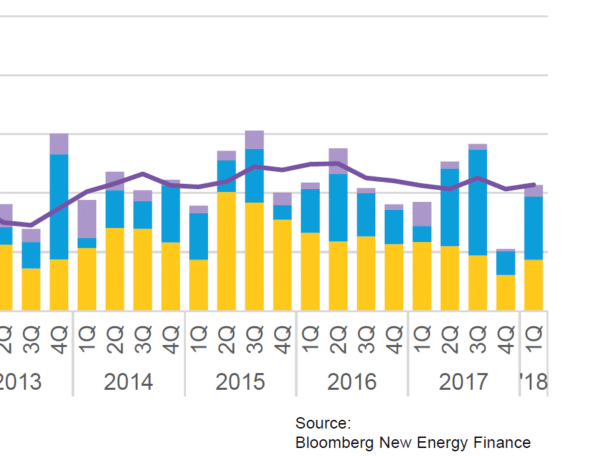The United States was not much more than a footnote in Bloomberg New Energy Finance’s (BNEF) latest report on global clean energy investment trends. With so much activity going on in the rest of the world, it should be noted that the United States was clearly not where the action was at, particularly as regards solar.
The data shows that solar investments have still not recovered from the sharp decline in investments seen in Q4 2017, which would directly follow the injury finding on the Section 201 case in late September. In fact, despite rebounding to over $4 billion, the Q1 level of solar investment was the second-lowest in the last three years.

BNEF’s Head of Solar Analysis Jenny Chase notes that effects were the sharpest in distributed solar. “Large-scale asset financing didn’t take that much of a hammering,” notes Chase. However, she says that small-scale solar finance is actually down from Q4 levels.
Chase also notes that much of the slowdown see in the United States is a combination of the hangover from the overbuild in 2016 to meet the anticipated drop-down of the Investment Tax Credit (ITC), combined with a “pull-forward” of projects in previous quarters to avoid tariffs under Section 201.
This is not to say that other factors like tax reform are not affecting the market. However, Chase says that she expects these to have an effect “over a slightly larger timeframe”.
BNEF’s findings mesh somewhat with those of Mercom Capital. While Mercom’s quarterly solar funding report is not broken down between U.S. and global investments, many of the measures that it tracks, such as venture capital investments, public market financing and debt financing, are heavily weighted towards the United States. All of those metrics saw a decline from both on a quarter-to-quarter and year-over-year basis. Additionally Mercom reported a fall in large-scale project funding.
By the measures of either report, the last two quarters have been difficult for the U.S. solar industry. However, it is important to note that with the falling cost of solar and energy storage, more of each can be deployed with less money – meaning that a fall in investment does not directly correlate with equivalent declines in deployment.
As BNEF’s report also covers other clean energy sources including wind, and shows U.S. wind financing recovering after a sharp drop in Q4.
This content is protected by copyright and may not be reused. If you want to cooperate with us and would like to reuse some of our content, please contact: editors@pv-magazine.com.









By submitting this form you agree to pv magazine using your data for the purposes of publishing your comment.
Your personal data will only be disclosed or otherwise transmitted to third parties for the purposes of spam filtering or if this is necessary for technical maintenance of the website. Any other transfer to third parties will not take place unless this is justified on the basis of applicable data protection regulations or if pv magazine is legally obliged to do so.
You may revoke this consent at any time with effect for the future, in which case your personal data will be deleted immediately. Otherwise, your data will be deleted if pv magazine has processed your request or the purpose of data storage is fulfilled.
Further information on data privacy can be found in our Data Protection Policy.